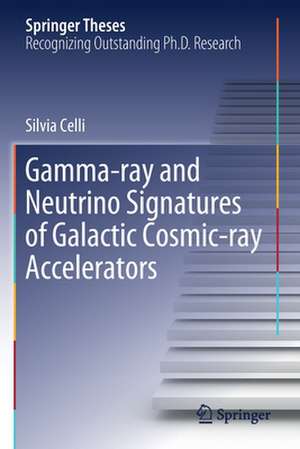Gamma-ray and Neutrino Signatures of Galactic Cosmic-ray Accelerators: Springer Theses
Autor Silvia Cellien Limba Engleză Paperback – 2 ian 2021
| Toate formatele și edițiile | Preț | Express |
|---|---|---|
| Paperback (1) | 639.41 lei 6-8 săpt. | |
| Springer International Publishing – 2 ian 2021 | 639.41 lei 6-8 săpt. | |
| Hardback (1) | 645.60 lei 6-8 săpt. | |
| Springer International Publishing – 2 ian 2020 | 645.60 lei 6-8 săpt. |
Din seria Springer Theses
- 18%
 Preț: 997.88 lei
Preț: 997.88 lei -
 Preț: 389.88 lei
Preț: 389.88 lei - 15%
 Preț: 646.94 lei
Preț: 646.94 lei - 18%
 Preț: 943.43 lei
Preț: 943.43 lei -
 Preț: 399.29 lei
Preț: 399.29 lei - 18%
 Preț: 944.99 lei
Preț: 944.99 lei - 15%
 Preț: 636.80 lei
Preț: 636.80 lei - 18%
 Preț: 941.05 lei
Preț: 941.05 lei - 15%
 Preț: 643.16 lei
Preț: 643.16 lei - 15%
 Preț: 642.68 lei
Preț: 642.68 lei - 18%
 Preț: 1103.62 lei
Preț: 1103.62 lei - 20%
 Preț: 558.83 lei
Preț: 558.83 lei - 18%
 Preț: 1112.30 lei
Preț: 1112.30 lei - 18%
 Preț: 944.19 lei
Preț: 944.19 lei - 18%
 Preț: 1109.92 lei
Preț: 1109.92 lei - 18%
 Preț: 1217.27 lei
Preț: 1217.27 lei - 15%
 Preț: 640.06 lei
Preț: 640.06 lei - 15%
 Preț: 636.45 lei
Preț: 636.45 lei - 15%
 Preț: 640.06 lei
Preț: 640.06 lei - 15%
 Preț: 640.88 lei
Preț: 640.88 lei -
 Preț: 389.70 lei
Preț: 389.70 lei - 20%
 Preț: 563.91 lei
Preț: 563.91 lei -
 Preț: 393.35 lei
Preț: 393.35 lei - 15%
 Preț: 637.93 lei
Preț: 637.93 lei - 15%
 Preț: 641.85 lei
Preț: 641.85 lei - 18%
 Preț: 1225.94 lei
Preț: 1225.94 lei - 20%
 Preț: 551.36 lei
Preț: 551.36 lei - 18%
 Preț: 1229.10 lei
Preț: 1229.10 lei - 15%
 Preț: 639.25 lei
Preț: 639.25 lei - 18%
 Preț: 999.45 lei
Preț: 999.45 lei - 15%
 Preț: 640.06 lei
Preț: 640.06 lei - 18%
 Preț: 1220.45 lei
Preț: 1220.45 lei - 18%
 Preț: 1116.26 lei
Preț: 1116.26 lei - 18%
 Preț: 1110.72 lei
Preț: 1110.72 lei - 18%
 Preț: 1000.87 lei
Preț: 1000.87 lei - 18%
 Preț: 891.17 lei
Preț: 891.17 lei - 15%
 Preț: 640.06 lei
Preț: 640.06 lei - 5%
 Preț: 1154.07 lei
Preț: 1154.07 lei - 15%
 Preț: 635.96 lei
Preț: 635.96 lei - 15%
 Preț: 640.88 lei
Preț: 640.88 lei -
 Preț: 387.20 lei
Preț: 387.20 lei - 18%
 Preț: 1109.92 lei
Preț: 1109.92 lei -
 Preț: 385.25 lei
Preț: 385.25 lei -
 Preț: 385.25 lei
Preț: 385.25 lei - 18%
 Preț: 1112.30 lei
Preț: 1112.30 lei - 18%
 Preț: 999.45 lei
Preț: 999.45 lei -
 Preț: 386.99 lei
Preț: 386.99 lei - 15%
 Preț: 637.13 lei
Preț: 637.13 lei - 20%
 Preț: 554.21 lei
Preț: 554.21 lei - 20%
 Preț: 555.59 lei
Preț: 555.59 lei
Preț: 639.41 lei
Preț vechi: 752.24 lei
-15% Nou
Puncte Express: 959
Preț estimativ în valută:
122.35€ • 133.32$ • 103.10£
122.35€ • 133.32$ • 103.10£
Carte tipărită la comandă
Livrare economică 23 aprilie-07 mai
Preluare comenzi: 021 569.72.76
Specificații
ISBN-13: 9783030331269
ISBN-10: 3030331261
Pagini: 252
Ilustrații: XXI, 252 p. 91 illus., 83 illus. in color.
Dimensiuni: 155 x 235 mm
Greutate: 0.39 kg
Ediția:1st ed. 2019
Editura: Springer International Publishing
Colecția Springer
Seria Springer Theses
Locul publicării:Cham, Switzerland
ISBN-10: 3030331261
Pagini: 252
Ilustrații: XXI, 252 p. 91 illus., 83 illus. in color.
Dimensiuni: 155 x 235 mm
Greutate: 0.39 kg
Ediția:1st ed. 2019
Editura: Springer International Publishing
Colecția Springer
Seria Springer Theses
Locul publicării:Cham, Switzerland
Cuprins
Introduction.- Propagation and Radiation of Accelerated Particles In Super-Nova Remnants With Clumpy Structures.- Particle Escape From Supernova Remnants.- The Galactic Center Region.- Sensitivity studies for Gamma-Ray and Neutrino Telescopes.- Summary and Conclusions.- Appendix.
Notă biografică
Silvia Celli received her Ph.D. in Astroparticle Physics from Gran Sasso Science Institute in 2019. Later, she has been working as a researcher at the Max-Planck-Institut für Kernphysik in Heidelberg (Germany). Her main research interests are related to the high-energy emissions of astrophysical sources in the multi-messenger framework, in particular to the gamma-ray and neutrino signatures of Galactic cosmic-ray accelerators. She is a member of three large international scientific collaborations, namely ANTARES, CTA, and KM3NeT.
Textul de pe ultima copertă
This book addresses three “hot” topics concerning the general problem of the origin of Galactic cosmic rays, namely (1) the acceleration, propagation, and radiation of particles in supernova remnants; (2) very high energy neutrinos from the Galactic Center; and (3) the potential held by the next-generation gamma-ray and neutrino detectors CTA and KM3NeT for studying extended non-thermal sources in the Galaxy. The topics are intrinsically connected to determining the nature (“hadronic or leptonic?”) of gamma-ray emissions from young and middle-aged supernova remnants and the search for cosmic-ray PeVatrons. The results and conclusions provided here are based on extensive analytical and numerical simulations, which are formulated and presented in a straightforward format that can be readily used in the interpretations of gamma-ray and neutrino observations, as well as for confident predictions for future measurements.
Caracteristici
Nominated as an outstanding Ph.D. thesis by the Gran Sasso Science Institute, L’Aquila, Italy Provides a comprehensive review of the search for Galactic cosmic-ray sources Presents technical descriptions of numerical and analytical methods for the solution of partial differential equations (in particular for the convective–diffusive particle transport and magnetohydrodynamic equations)
